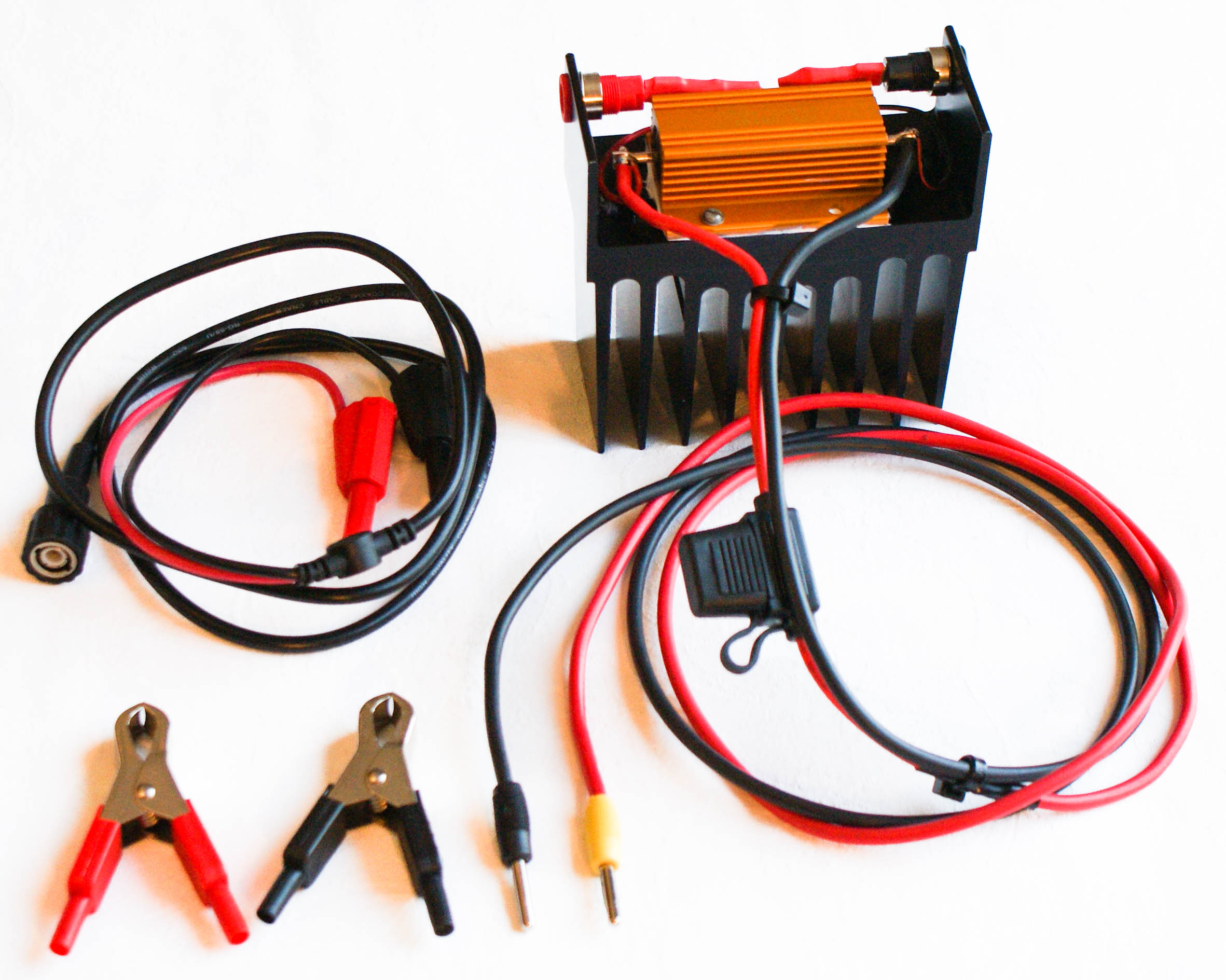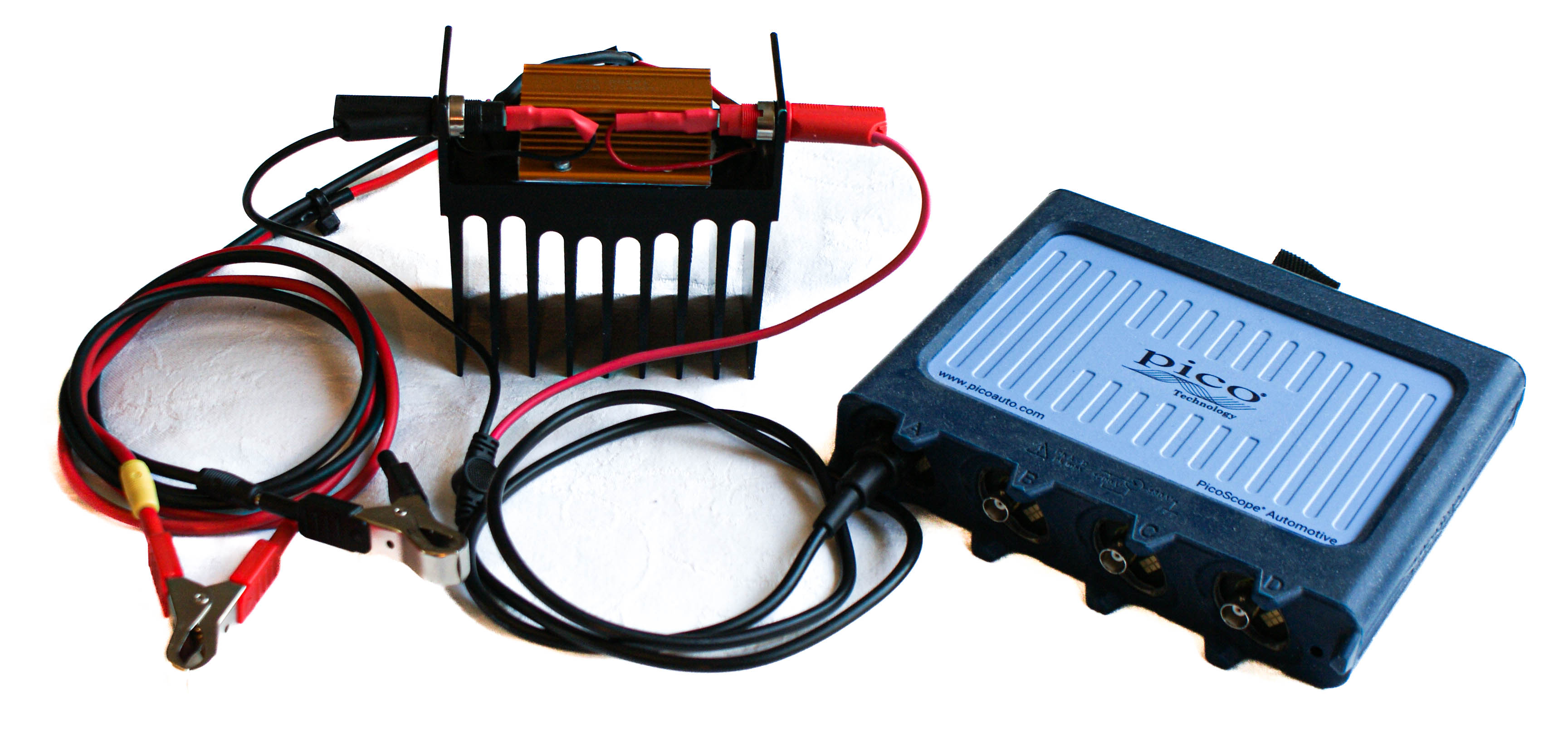
Parasitic Drain Tester Kit
- Parasitic Drain Tester Components
- 1 x Resistor 0.1 Ohm 100W 5%
- 2 x 4mm Sockets for BNC Test Lead
- 1 x ATS Fuse Holder with 30A Blade Fuse
- 2 x 1m High-current Cables, with...
- 2 x 30A 4mm Plugs for Battery Clips
- 1 x Heat-sink
- 1 x 1m Shrouded BNC to Shrouded 4mm Stackable Plugs Test Lead
- 2 x Battery Clip PICO-TA157 and PICO-TA158
| Resistance | 0.1 Ohm |
| Output Voltage | 100mV/A |
| Tolerance | 5% |
| Max Continuous Current | 20A |
| Max Peak Current (<20sec) | 30A |
| Max Voltage | 50V |
| Fuse | 30A ATS |
| Heat-sink | 1.5K/W |
| Heat-sink Dimensions | 114x120x50mm |
| The Heat-sink is electrically isolated | |
Understanding the Parasitic Drain Tester
The Garage Lube Parasitic Drain Tester can be used with your PicoScope or your multimeter for testing parasitic drain safely, over long periods of time. It acts as a current shunt and can also be used to measure current up to 30A.
What is Parasitic Drain?
When a vehicle's ignition is switched off, one can be forgiven for thinking that everything stops consuming power. In older vehicles that was true, the ignition switched everything off. Modern vehicles have multiple computers (ECUs), which may continue to draw current from the battery, often for a considerable time after the ignition is switched off.
Systems such as car alarms, tracking devices and keyless entry can continue to draw current.
Of course, a fault can develop, which can increase the battery drain and the parasitic drain test is used to track down the problem.
Measuring Current
This test is performed by measuring the current drawn from the battery over an extended period whilst the ignition is off. You can measure current using low current amp clamps such as the PicoBNC+ PICO-TA473 or Standard BNC current clamps.
The standard BNC current clamps have the disadvantage that they are powered by an internal battery that can go flat before your test is complete. However, all of these current clamps are based on a hall-effect sensor (magnetic field), and they can drift, producing erroneous results over a long test period. This is why current clamps need to be 'zeroed'.
Test Period
Parasitic drain testing is usually a long process. A 4425A PicoScope with PicoScope 7 software can be used to test for over 13 hours. You can use PicoLog software with your PicoScope to run the test over many days. This is why drift can pose a problem.
The way to solve that problem is to use a shunt resistor to monitor current.
Over-current
During the test, someone might open the vehicle's door. The interior light might turn on. Multiple ECUs might wake up and the vehicle might suddenly start drawing many amps from the battery. Detecting current draw is, after all, the point of a parasitic drain test.
Using (and abusing) a Current Shunt Resistor
In many test procedures, a high wattage 0.1 ohm resistor is used as a current shunt. This is the correct way to monitor current in a parasitic drain test. There can be four serious problems with this setup if:
- the resistor does not have a heat-sink
- the resistor is under-rated in terms of power
- the voltage is not measured directly across the resistor (kelvin sense) and / or
- the resistor does not have a fuse.
We will address each of these problems is turn.
No Heat-sink
When power is dissipated in an electronic component such as a resistor, it starts to heat up. If the heat cannot be removed, then the temperature of that component starts to rise. Most component data-sheets include a free-air thermal resistance specification. This is usually expressed as K/W (Kelvin per Watt). If, for example, a device (without a heat-sink) is rated at 20K/W then every watt dissipated results in a rise in temperature of 20°C. If you pass 10 Amps through a 0.1 ohm resistor, the power dissipated is 10 Watts
P=I2R
which means: Power = Current Squared multiplied by the Resistance.
With no heat-sink, at 20K/W, the temperature will increase to 200°C above ambient, very quickly!
A heat-sink reduces the thermal resistance by providing a large surface area to allow the heat to escape into the atmosphere. The Garage Lube Parasitic Drain Tester Heat-sink is rated at about 1.5K/W. If you pass 20A through its 0.1 ohm resistor, the power dissipated will be 40W, four times the power in the example above. The temperature will certainly rise but because the heat-sink has reduced the thermal resistance, the temperature will only rise to 60°C above ambient.
WARNING: Using a high-wattage resistor without a heat-sink can be dangerous and can even cause a fire.
Power Rating, Maximum Current and the Fuse
Resistors have a power rating. Often the resistors used in parasitic drain tests are under-rated. The maximum current that can be handled by a selection of 0.1 ohm resistors (with a correctly sized heat-sink) is as follows:
- 5W: 7A
- 10W: 10A
- 20W: 14A
- 50W: 22A
- 100W: 31A
The applicable formula is:
I = √(P/R)
which means: Current = Square Root of (Power divided by the Resistance).
The Garage Lube Parasitic Drain Tester uses a 100W 0.1 Ohm Resistor. We have rated the tester at 20A continuous to keep the heat-sink temperature within manageable levels but the tester can handle peaks of up to 30A. A 30A fuse is included to protect the resistor.
Never increase the fuse above 30A. You can, however, reduce it to 20A or lower if you want to limit the temperature rise of the resistor and the heat-sink safely.
Voltage Measurement of Current
The 0.1 Ohm Resistor is used to measure current. This is a simple application of Ohm's Law.
I=V/R
which means: Current = Voltage divided by the Resistance.
The resistor is 0.1 Ohms and therefore 100mV appears across the resistor for every amp flowing through it. At 20A, 2V appears across the resistor.
It is important to measure the voltage across the resistor only. If you include other circuit elements for example connections, cables and the fuse, the resistance will change which results in measurement errors.
Garage Lube's Parasitic Drain Tester has independent measurement points connected directly to the resistor to avoid these errors. This is especially useful with the 4x25 and 4x25A PicoScopes with isolated channel grounds.
Optional Calibration
The 0.1 Ohm resistor has a tolerance of 5%. You cannot measure the resistance of it accurately using a standard multi-meter. You should use a milli-ohm meter like the new Pico Motor Tester and Milli-Ohm meter. The 0.1 Ohm resistor leads have intentionally, not been insulated and are accessible to allow you to measure the resistance and use the actual value to determine the current flow more accurately.
The tester is calibrated when it is manufactured and the actual resistance is recorded on a label. You can set up a custom probe in PicoScope 7 to match the calibrated value and display the correct current.
Parasitic Drain Tester Basic Usage Instructions

Connecting to the PicoScope
Connect the two 4mm connectors on the supplied test lead to the red and black 4mm sockets on the sides of the heat-sink. These sockets are connected directly to the resistor (Kelvin Sense) which means that the reading will be accurate. Connect the BNC connector to your PicoScope. The red lead is the channel input and the black lead is channel ground. You can also use a Pico Premium Test Lead which provides additional length if your PicoScope isn't near to the Parasitic Drain Tester.
The High Current Leads
The Black High-Current Lead is connected directly to the resistor, whereas the red lead (with the yellow plug) is connected via the resistor.
Attach the battery clips (or another appropriate accessory) to the ends of the cable. Ensure that the ignition is off. Usually, the negative terminal of the battery is disconnected and the black lead is connected to negative. The red lead with the yellow plug is connected to the vehicle body. However, you can also connect into the positive battery lead if more convenient.
PicoScope Setup
You can just monitor voltage and mentally convert it to current. At 30A (the maximum) the voltage out will be 3V so the 5V range would be appropriate. You can create a custom probe for your Parasitic Drain Tester. Using PicoScope 7 and a 4x25 or 4x25A PicoScope, you can set up the scope to 5000 seconds per division which will yield just less than 14 hours of sampling at 5000 samples per second. Using PicoLog, you can monitor parasitic drain for days.
Current Shunt
The Parasitic Drain Tester can be used as a general purpose current shunt to measure currents up to 30A, using you PicoScope or a multi-meter.
FAQ and Warnings
Why is it not built in a box?
The Parasitic Drain Tester dissipates power when high currents are being measured.
The heat-sink needs to be open to dissipate that heat. Enclosing the heat-sink
would substantially reduce the current able to be measured by the Parasitic Drain
Tester. Never cover or enclose the unit, or it may overheat.
When high currents are measured, the unit's temperature will rise. Beware of hot surfaces when testing with high current.
Please note that it is intended for low voltage applications only.
Please visit our Garage Lube Parasitic Drain Tester page for pricing (coming soon) and more details.




